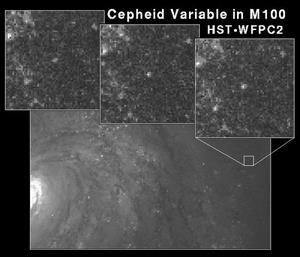[/caption]
If an alien species wanted to communicate with Earthlings, or any other civilization that might be out there, how might they do it? Some have proposed microwaves, neutrinos or lasers, or even
moving stars around into patterns
. But why wouldn't aliens just use the internet? The Cepheid Galactic Internet, that is. A group of scientists has proposed that a sufficiently advanced civilization could use Cepheid variable stars as beacons to transmit information throughout the galaxy and beyond. These stars can be seen from long distances and, the scientists say, any technologically advanced civilization would likely observe
Cepheid variables
as distance markers. The group of physicists and astronomers from Hawaii and California propose that Cepheids and any other regular variable stars should be searched for signs of phase modulation and patterns which could be indicative of intentional signaling.
In their paper, the group of scientists proposes that advanced civilizations hoping to communicate would want to use a form of communication with a high data rate, just as everyone on Earth would prefer broadband for their internet. Microwaves and lasers have problems with resolution and noise, while photons or neutrinos would take an enormous amount of power to send messages long distances. And moving stars around? Well, that sounds pretty difficult if not labor intensive. So how about something akin to a T1 line that is already established? All that would need to be done is to "tickle" the star, as the scientists call it, or tweak the Cepheid, to send a message. The researchers write, "Recently, some authors have driven home the point that it is far more energetically practical for transmitting large amounts of data to place long lasting artifacts in stellar systems to which the ETI (extra terrestrial intelligence) may wish communicate information (their history for example) as intelligent life matures and becomes capable of decoding this 'Rosetta stone.'â€
By "tickling" the star, with the delivery of a relatively small amount of energy via neutrinos or other forms of power pulses at the right time could trigger the Cepheid to a specific variability, and a message could be encoded within that variability.
The researchers admit the civilization attempting this would have to be highly advanced. But if some civilization has in fact created a message and sent it via the Cepheid Galactic Internet, all we have do to is open our inbox.
Who knows, they could be on to something. They've even discussed their proposal with
Freeman Dyson.
"It may be a long shot," they write, "but should it be correct, the payoff would be immeasurable for humanity. The beauty of this suggestion seems to be simply that the data already exists, and we need only look at the data in a new way."
Sources: arXiv,
On Orbit
 Universe Today
Universe Today
